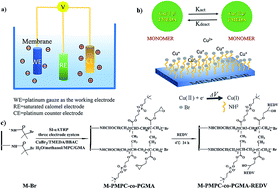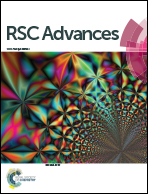Modification of a polyethersulfone membrane with a block copolymer brush of poly(2-methacryloyloxyethyl phosphorylcholine-co-glycidyl methacrylate) and a branched polypeptide chain of Arg–Glu–Asp–Val
Abstract
Polyethersulfone (PES) has good thermal stability, superior pH, chlorine tolerance, and excellent chemical resistance; however, the hydrophilicity and biocompatibility of PES need to be improved for its real applications. In this study, we report a surface modification method for the preparation of a functional PES membrane with hydrophilic polymer chains (MPC and GMA) via surface-initiated electrochemically-mediated atom-transfer radical polymerization (SI-eATRP) technology, and the Arg–Glu–Asp–Val polypeptide groups (REDV) were immobilized onto the modified membrane by a ring-opening reaction. XPS and SEM were used to analyze the chemical composition and morphology of the modified membrane surfaces, confirming that the hydrophilic polymer chains MPC and GMA and the polypeptide group REDV were successfully grafted onto the PES membrane surface. The static water contact angle decreased from 89° to 50–65°, and the hydrophilic property of the modified membrane was enhanced. The water flux increased from 4.29 L m−2 h−1 for the pristine PES membrane to 25 L m−2 h−1 for the modified membrane with PGMA chains grafted on it and REDV functional groups immobilized on it; note that the antifouling tests showed that all the modified membranes had the higher flux recovery ratio values (FRR) of above 80% than the pristine PES membrane (about 60%), and the APTT for the modified membrane increased from 46 s to 93 s, indicating that these modified membranes could be applied in the separation and blood purification fields.



 Please wait while we load your content...
Please wait while we load your content...